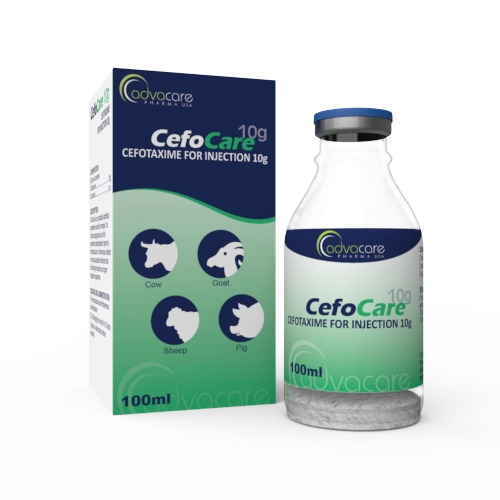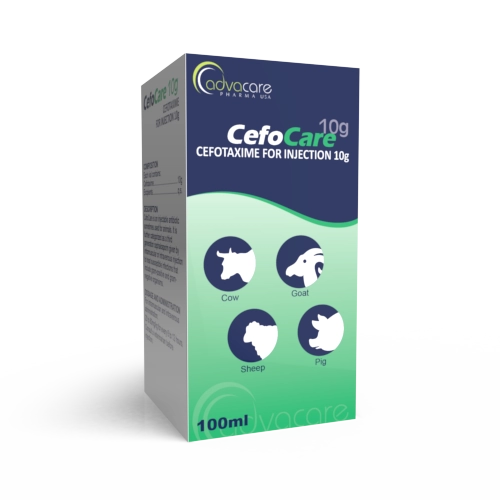What is Cefotaxime?
- Antibiotic
- Cat,
- Cow,
- Dog,
- Goat,
- Poultry,
- Sheep,
- Pig
Active Ingredients: Cefotaxime
Cefotaxime for Injection is an antibiotic drug used to treat or prevent certain bacterial infections in dogs, cats, poultry and livestock animals like cows or pigs. It is typically used for infections like shipping fever or ones that need intravenous treatment, such as bacteremia or bone and joint infections.
As cefotaxime is known to cross the blood-brain barrier, it can be employed to treat sepsis caused by gram-negative bacteria. Sepsis is a systemic inflammatory response caused by a severe bacterial infection and may lead to multiple organ failure if not treated immediately. Because cefotaxime can go through the blood-brain barrier, it becomes valuable in combating septic conditions that involve the central nervous system.
Cefotaxime is a third-generation antibiotic that falls within the cephalosporin family. It works by inhibiting cell wall synthesis within the bacteria. This antibiotic shows broad-spectrum bactericidal activity against many gram-positive and gram-negative bacteria, including E. Coli.
The drug’s efficacy has been demonstrated in a variety of infections, ranging from respiratory to urinary tract. It is also used to treat skin and soft tissue infections, including wounds and abscesses, which are primarily caused by susceptible strains of bacteria. Cefotaxime may also be prescribed for serious systemic infections like septicemia in small animals.
When determining the dosage, consider the species, age, and overall health status of the animal. The route of administration, usually intramuscular or intravenous, and frequency of dosing, commonly once or twice daily, depends on the severity and location of the infection.
Cefotaxime is not an effective treatment for infections caused by Enterococcus, Pseudomonas aeruginosa, and methicillin-resistant Staphylococcus. Such organisms have developed resistance or inherent insensitivity to this class of antibiotics, likely due to enzymatic degradation, alterations in the bacterial target sites, or efflux mechanisms that expel the drug. Cefotaxime use, therefore, should always be preceded by bacterial culture and sensitivity tests to ensure efficacy.
Basil Hygiecare is a global distributor and producer of Cefotaxime for Injection. This veterinary medicine is produced in GMP-certified factories located in China, India, and the USA. We routinely inspect these facilities to ensure our products meet health, safety, and environmental standards.
Why are we a trusted Cefotaxime manufacturer?
Basil Hygiecare is a leading GMP manufacturer of Cefotaxime Injection for veterinary use. Our company was established with the aim of providing excellent value to our veterinary distributors by concentrating on competitively priced, high-quality veterinary pharmaceuticals with market-tailored solutions.
Over the past 20 years, Basil Hygiecare has proven to be a trusted Cefotaxime manufacturer and supplier of 100+ veterinary injections in over 65 countries.
Precautions
Do NOT use Cefotaxime for Injection for an animal that:
- has a known allergy or hypersensitivity to cefotaxime or any other cephalosporin antibiotic.
- is concurrently taking drugs that may interact adversely with cefotaxime.
- has a history of severe gastrointestinal reactions to antibiotics.
- is diagnosed with renal impairment or failure.
- is pregnant or lactating, unless the potential benefit justifies the risk to the offspring.
- has a history of bleeding disorders (cephalosporins may interfere with blood clotting mechanisms).
Treatment with this drug should be administered with caution for an animal that:
- has hepatic impairment.
- has a history of gastrointestinal reactions to cephalosporins.
- is elderly or in a debilitated state, as they might be more sensitive to potential side effects.
Cefotaxime for Injection may cause pain when delivered intramuscularly or subcutaneously.
What are the most common animals Cefotaxime for Injection is used for?
Specific uses for animals include:
- Cats and Dogs: Cefotaxime is used to treat lower respiratory tract infections, uterine infections, dermatological infections, intra-abdominal infections, bone and joint infections, central nervous system (CNS) infections, and bacteremia/sepsis.
- Cows, Sheep, and Goats: The drug is usually prescribed for respiratory diseases, especially those caused by bacteria like Mannheimia haemolytica or Pasteurella multocida2.
- Poultry and Pigs: Cefotaxime is usually applied to manage systemic infections, with careful consideration of the appropriate dosage and withdrawal times.
Cefotaxime is a versatile antibiotic that has proven its capability to manage infections across a wide range of animals, from companion pets to livestock. Its broad-spectrum efficacy makes it a valuable drug in veterinary medicine, although its use should be guided by sensitivity testing to prevent resistance issues.
Uses
What is Cefotaxime used for?
It is used to treat and control bacterial infections such as:
- respiratory infections, such as shipping fever caused by Pasteurella haemolytica or P. multocida (in calves and lambs)
- bacterial enteritis or diarrhea caused by E. Coli, Salmonella, or Clostridia
- skin and soft tissue infections
- orthopedic infections
- bacteremia
What animals can be treated with Cefotaxime for Injection?
This medicine is recommended for poultry, such as chickens, turkeys, and ducks. It’s also used for livestock, such as cows, sheep, goats, and pigs.
How is Cefotaxime for Injection used?
This drug has been manufactured as a powder for reconstitution. Once reconstituted with the appropriate diluent, the solution is administered either intramuscularly or intravenously. The dosage and duration of treatment depend on the type of infection, the animal’s weight, and its general health status.
What are the withdrawal times for Cefotaxime for Injection?
For cattle, the withdrawal time typically is 4-5 days for meat and 2 days for milk. For poultry, the withdrawal time is typically 4-6 days for meat. This knowledge helps ensure that no drug residue remains in the animal products when consumed by humans.
What is the recommended dosage of Cefotaxime for different animals?
Dosages vary based on the species, age, and weight of the animal, as well as the severity and type of infection.
Are there any contraindications associated with Cefotaxime for Injection?
Yes, animals with a known hypersensitivity or allergy to cephalosporin antibiotics should not receive Cefotaxime. It is also not recommended for animals with a history of severe gastrointestinal disturbances, especially those associated with antibiotic use.
Can Cefotaxime for Injection be used concurrently with other medications?
When using Cefotaxime alongside specific drugs, interactions might occur. Inform the veterinarian of any other medications or supplements the animal is taking before starting treatment.
What should be done if an adverse reaction occurs?
Discontinue use immediately and contact a veterinarian. Supportive measures may be required depending on the severity of the reaction. For allergic reactions, administration of antihistamines or corticosteroids may be needed to reduce the immune response, and in severe cases, epinephrine may be required for anaphylactic reactions. For gastrointestinal upset, give fluids to prevent dehydration and provide electrolyte replacement.
Are there any resistance concerns with the use of Cefotaxime?
As with other antibiotics, misuse or overuse of this drug may lead to the development of resistant bacteria. This is why the drug should be used only as prescribed by a veterinarian. The entire course of treatment should also be completed, even if symptoms improve.
Is monitoring required while an animal is on Cefotaxime?
Yes, the veterinarian supervising the treatment may recommend periodically assessing organ function, including the kidney and liver.
How should Cefotaxime for Injection be stored?
This medication should be stored in a dark, dry location under 30°C. Avoid freezing the reconstituted solution and ensure the container remains tightly sealed to prevent contamination.
How should Cefotaxime for Injection be disposed?
Cefotaxime should not be discarded with regular household waste. Expired or unused Cefotaxime should be disposed of according to local guidelines to prevent environmental contamination.
Dosage
How much Cefotaxime should be given to cows?
After reconstitution, the usual dose for cows is about 15ml per 100kg, given for 3-5 consecutive days.
How much Cefotaxime should be given to dogs and cats? The usual dose for dogs and cats is 20 to 50mg/kg every 6 to 12 hours.
How much Cefotaxime should be given to poultry? The typical dose for chickens and other poultry is 10mg/kg at 12-hour intervals.
How are dosages determined in the use of Cefotaxime for Injection? Dosages depend on the type of animal, body weight, severity and type of infection, duration of treatment, and overall health status. The use of other medications and previous exposure to antibiotics are also considered.
Is the dosage the same for all bacterial infections? No, this depends on the type and severity of the infection. More severe cases might require higher doses or more frequent administration.
Can the dosage of Cefotaxime be adjusted during treatment? Yes, depending on the discretion of the veterinarian. If there is no improvement observed during the course of treatment, the veterinarian might reassess the care plan and either alter the dose or switch to a different antibiotic.
Refer to a veterinary doctor or pharmacist for guidelines on dosage.
Side Effects
As with all pharmaceuticals, some unwanted effects can occur from the use of Amoxicillin Sodium for Injection.
Some common side effects may include but are not limited to gastrointestinal effects (appetite loss, vomiting, diarrhea).
Serious side effects may include:
- allergic reaction (skin rash, fever, facial swelling, or difficulty breathing)
- incoordination while walking
- prolonged lack of appetite (in cats)
- seizures
- nephritis
- leukopenia
- thrombocytopenia
- Coombs-positive hemolytic anemia
If the drug is constantly administered on only one injection site, thrombophlebitis might occur.
For a comprehensive list of all possible side effects of this medication, consult a veterinarian.







